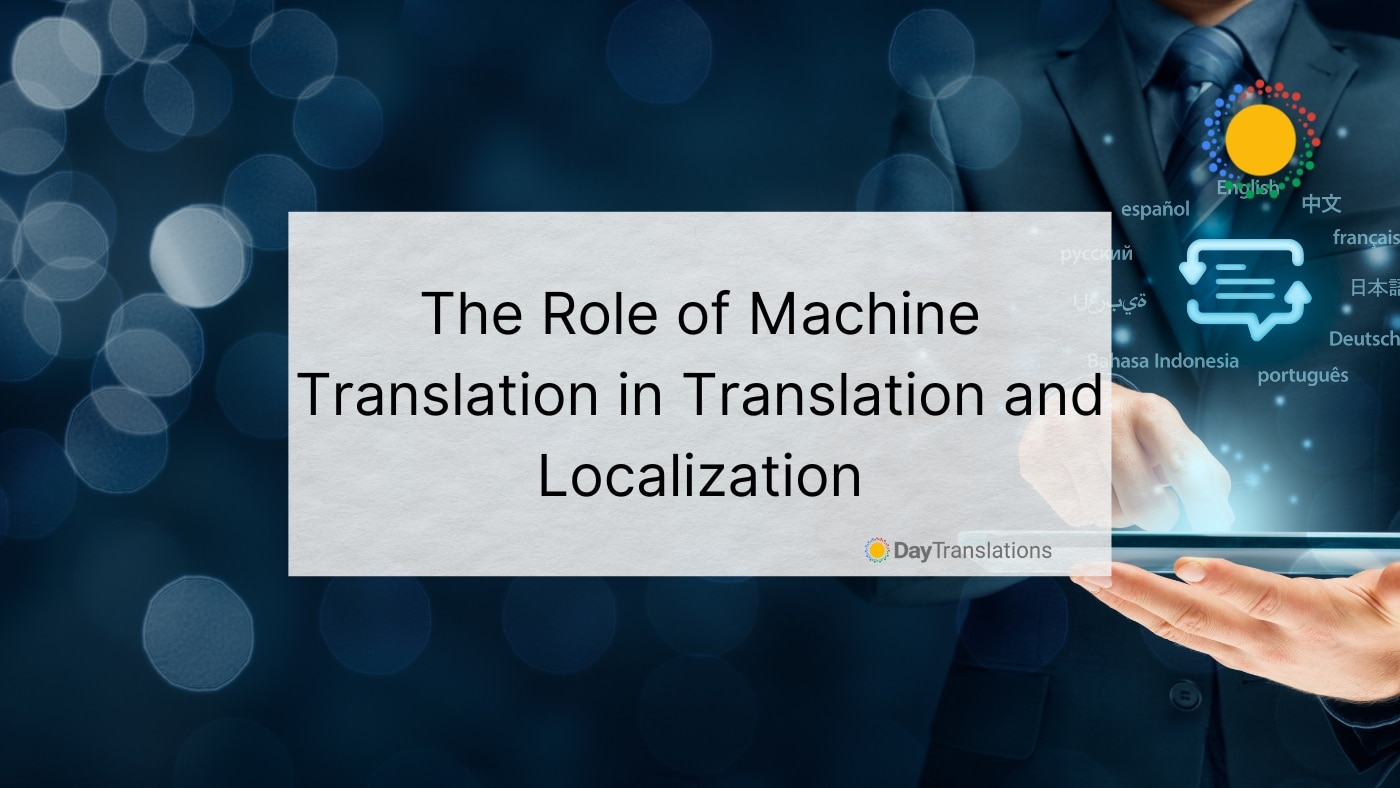In today’s globalized world, the need for effective communication across languages and cultures has never been more crucial. The translation and localization industry plays a vital role in bridging this communication gap, helping businesses and organizations expand their reach and connect with audiences worldwide.
Machine translation (MT) has emerged as a powerful tool in this industry, enabling faster and more efficient translation processes. However, there are ongoing debates about the effectiveness and limitations of MT and its impact on human translators. In this article, we will explore the role of machine translation in translation and localization, its benefits and drawbacks, and the future of this technology.
Machine Translation and its Relevance in the Language Services Industry
Machine translation (MT) is a rapidly evolving technology that has become increasingly relevant in the translation and localization industry. MT refers to the use of software and algorithms to automatically translate text from one language to another. While MT has been around for several decades, recent advancements in artificial intelligence and natural language processing have significantly improved its capabilities, making it a valuable tool for businesses and organizations seeking to expand their global reach. In this article, we will explore the basics of machine translation, its advantages and limitations, its impact on human translations, and the future of this technology in the translation and localization industry.
The Basics of Machine Translation
Machine translation (MT) refers to the use of software and algorithms to automatically translate text from one language to another. MT systems can be classified into three main categories based on the type of approach used:
Rule-Based Machine Translation
Rule-based machine translation is the oldest and most traditional form of machine translations. In rule-based MT, the system relies on a set of pre-defined linguistic rules and dictionaries that cover multiple languages to analyze the source text and generate the target translation. These rules are created by human linguists and programmers, and the system’s output is only as good as the rules that have been defined.
Statistical Machine Translation
This type of machine translation uses statistical models to analyze large amounts of bilingual text data and identify patterns in the way words and phrases are translated from one language to another. The system then uses these patterns to generate the target translation. Statistical MT systems can be trained on different types of data, such as parallel corpora or multilingual texts, and can improve their accuracy over time as they receive more input.
Neural Machine Translation
This is the newest and most advanced form of machine translation. Neural MT uses artificial neural networks to model the way human brains process language. These networks can learn to map the input text to the output translation based on large amounts of training data. Neural MT systems have shown significant improvements in accuracy and fluency compared to earlier methods and are rapidly becoming the dominant approach in machine translation.
How Machine Translation Works
Machine translation (MT) systems work by breaking down the source text into smaller units, such as words or phrases, and then generating a corresponding translation for each unit. This process typically involves the following steps:
- Pre-processing: The source text is analyzed and cleaned up to remove any unwanted formatting, special characters, or other elements that may interfere with the translation process.
- Analysis: The source text is analyzed to identify its grammatical structure, syntax, and meaning. This may involve part-of-speech tagging, named entity recognition, and other linguistic analysis techniques.
- Translation: The source text is translated into the target language, either by applying pre-defined linguistic rules (in rule-based MT), or by using statistical or neural models to generate the translation.
- Post-processing: The translated text is reviewed and edited to correct any errors, inconsistencies, or unnatural language use that may have occurred during the translation process.
The quality of the machine translation output depends on several factors, such as the complexity of the source text, the language pair being translated, the quality of the training data (in statistical and neural MT), and the level of human post-editing or review that is applied to the output. While machine translation has made significant advances in recent years, it is not yet capable of producing fully accurate and natural-sounding translations for all types of content and languages.
What are the Advantages of Machine Translation in Translation?
In general, there are a few benefits of MT that can seem captivating. These include:
Faster Turnaround Times
Machine translation can translate text much faster than a human translator. This is especially useful for time-sensitive projects or large volumes of content that need to be translated quickly.
Reduced Costs
Since machine translation does not require a human translator to perform the translation, it can be much less expensive than traditional human translation. This can be a significant cost savings for businesses and organizations with large translation needs.
Increased Consistency and Accuracy
MT can be more consistent and accurate than human translation in some cases, especially when it comes to translating repetitive or technical content. It n can also help reduce the risk of errors or inconsistencies that can occur when multiple human translation professionals work on a project.
Greater Scalability
Modern MT can easily scale up to handle large volumes of content, while human translation may be limited by the availability of qualified translators. This makes machine translation a practical solution for organizations with a high volume of translation needs.
While MT has several advantages, it’s important to note that it’s not a perfect solution and has limitations, as we’ll discuss in the next section.
Limitations of Machine Translation Technology
The translation quality output can vary depending on several factors, such as the language pair being translated, the complexity of the content, and the quality of the training data used. As a result, MT is often used in conjunction with human translation, either as a starting point for post-editing or as a tool to aid human translators in their work. Some of the most significant drawbacks of MT include:
Limited Accuracy
Automatic translation is not yet able to produce fully accurate translations that are on par with human translation, particularly for complex or nuanced content. MT can struggle with idiomatic expressions, humor, cultural references, and other forms of language that require human interpretation.
Lack of Context
MT systems can have difficulty understanding the context of the source text, which can lead to mistranslations or inappropriate translations in some cases. MT systems typically work on a sentence-by-sentence basis and may not be able to capture the broader meaning or intent of a text.
Inability to Capture Style and Tone in the Translation Process
MT is generally unable to capture the style, tone, or voice of the original text. This can lead to translations that sound stilted, awkward, or even offensive in some cases.
Dependence on Training Data
Automated translation systems rely heavily on the quality and quantity of the training data used to train the system. If the training data is limited or of poor quality, the MT output may be inaccurate or inappropriate.
Lack of Cultural Sensitivity
MT may not be sensitive to cultural nuances or differences, which can lead to translations that are inappropriate or offensive in certain contexts.
While MT has made significant advances in recent years, it’s important to understand its limitations and to use it judiciously in conjunction with human translation or other translation tools. As with any technology, machine translation should be used as part of a larger translation strategy that considers the needs of the specific project and the target audience.
Accepting the Role of Machine Translation in Translation
MT has become an increasingly important tool in the translation and localization industry, offering several advantages such as faster turnaround times, reduced costs, increased consistency and accuracy, and greater scalability. However, it’s important to be aware of the limitations of this technology, including limited accuracy, lack of context, inability to capture style and tone, dependence on training data, and lack of cultural sensitivity.
While MT is not yet capable of producing fully accurate and natural-sounding translations for all types of content and languages, it can be a valuable tool when used judiciously in conjunction with human translation or other translation tools.
As MT technology continues to improve and evolve, it is likely to play an even more significant role in the translation and localization industry. Nevertheless, it’s important to remember that human translators and translation professionals will continue to play a critical role in ensuring accurate, culturally sensitive, and effective communication across different languages and cultures. By leveraging the strengths of both human and MT, businesses and organizations can meet their translation needs more effectively and efficiently.














Sorry, the comment form is closed at this time.